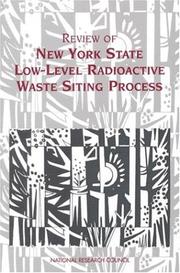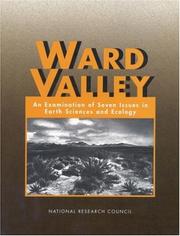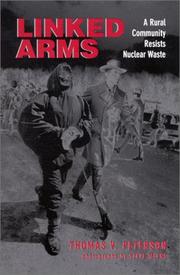| Listing 1 - 3 of 3 |
Sort by
|

ISBN: 0309055393 9786610191932 1280191937 0309561213 0585149976 9780585149974 9780309055390 0309175305 9780309175302 9781280191930 661019193X 9780309561211 Year: 1996 Publisher: Washington, D.C. : National Academy Press,
Abstract | Keywords | Export | Availability | Bookmark
 Loading...
Loading...Choose an application
- Reference Manager
- EndNote
- RefWorks (Direct export to RefWorks)
TECHNOLOGY & ENGINEERING --- Power Resources / Nuclear --- Low level radioactive waste disposal facilities --- Civil & Environmental Engineering --- Engineering & Applied Sciences --- Environmental Engineering --- Location --- LLRW disposal facilities --- LLRW disposal sites --- LLRW facilities --- LLRW storage facilities --- Low level radioactive waste disposal sites --- Low level radioactive waste facilities --- Low level radioactive waste storage facilities --- Radioactive waste sites

ISBN: 0309052882 9786610210855 1280210850 0309588154 0585113122 9780585113128 9780309052887 9781280210853 6610210853 9780309588157 Year: 1995 Publisher: Washington, DC : National Academy Press,
Abstract | Keywords | Export | Availability | Bookmark
 Loading...
Loading...Choose an application
- Reference Manager
- EndNote
- RefWorks (Direct export to RefWorks)
SCIENCE --- Earth Sciences / General --- Low level radioactive waste disposal facilities --- Hazardous waste sites --- Environmental Engineering --- Civil & Environmental Engineering --- Engineering & Applied Sciences --- Location --- Chemical landfills --- Contaminated sites --- Dumps, Toxic --- Hazardous waste disposal sites --- Hazardous waste facilities --- Superfund sites --- Toxic dumps --- LLRW disposal facilities --- LLRW disposal sites --- LLRW facilities --- LLRW storage facilities --- Low level radioactive waste disposal sites --- Low level radioactive waste facilities --- Low level radioactive waste storage facilities --- Waste disposal sites --- Radioactive waste sites

ISBN: 0585444137 9780585444130 0791451313 9780791451311 0791451321 9780791451328 9780791489789 0791489787 Year: 2002 Publisher: Albany : State University of New York Press,
Abstract | Keywords | Export | Availability | Bookmark
 Loading...
Loading...Choose an application
- Reference Manager
- EndNote
- RefWorks (Direct export to RefWorks)
Through character development, snappy dialogue, and vivid scenes, Linked Arms tells the story of a rural people's successful struggle to keep a major nuclear dump out of Allegany County in western New York. Five times over a twelve-month period hundreds of ordinary people—merchants, teachers, homemakers, professionals, farmers, and blue collar workers—ignored potential jail terms and large fines to defy the nuclear industry and governmental authority by linking arms in the bitter cold to thwart the siting commission through civil disobedience.The hearts and minds of the resisters emerge in the narrative, as we find out why these people found civil disobedience compelling, how they organized themselves, and what moral dilemmas they addressed as they fought for their convictions. While becoming more engaged in the resistance, they confronted critical issues in contemporary America: democratic decision making, environmental policy, legal rights, corporate responsibility, and the technology of nuclear waste.Some of the book's highlights include: conversations that took place between Governor Cuomo, Assemblyman Hasper, and the protestors, which thoughtfully probe who should bear the financial burden of a failed and dangerous technology; the scientific and technological issues discussed between Ted Taylor, a nuclear physicist who was one of the key people in the Manhattan project, and the leaders of the resistance; and the citizens' initiation of a lawsuit that eventually reached the Supreme Court and abrogated the central provision in the 1987 congressional law that mandated states build low-level nuclear dumps across the country. These dialogues and vignettes illustrate how the civil disobedience and dogged determination of the people of Allegany County changed the course of history.
Nonviolence --- Civil disobedience --- Environmental protection --- Public opinion --- Low level radioactive waste disposal facilities --- Non-violence --- Government, Resistance to --- Pacifism --- Civil resistance --- Disobedience, Civil --- Environmental quality management --- Protection of environment --- Environmental sciences --- Applied ecology --- Environmental engineering --- Environmental policy --- Environmental quality --- Opinion, Public --- Perception, Public --- Popular opinion --- Public perception --- Public perceptions --- Judgment --- Social psychology --- Attitude (Psychology) --- Focus groups --- Reputation --- LLRW disposal facilities --- LLRW disposal sites --- LLRW facilities --- LLRW storage facilities --- Low level radioactive waste disposal sites --- Low level radioactive waste facilities --- Low level radioactive waste storage facilities --- Radioactive waste sites --- Citizen participation. --- Public opinion. --- Location
| Listing 1 - 3 of 3 |
Sort by
|

 Search
Search Feedback
Feedback About UniCat
About UniCat  Help
Help News
News